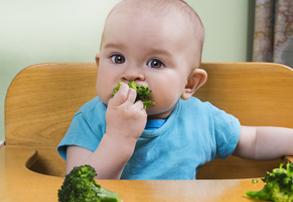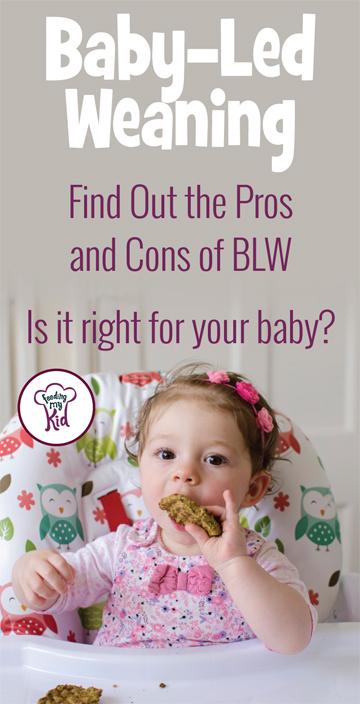 Baby-Led Weaning (BLW) also known as self-feeding, is the process of skipping the spoon-feeding stage (baby food puree stage) and going straight to solid
Baby-Led Weaning (BLW) also known as self-feeding, is the process of skipping the spoon-feeding stage (baby food puree stage) and going straight to solid
foods.
This doesn’t mean you will be giving
your baby a raw carrot stick to chew on. You will make foods soft and age appropriate for your baby to eat.
Check out our mega list of Baby-Led
Weaning first foods/ finger foods.
Your baby will be able to explore real food with his or her own hands. Your baby may not actually eat any food the first few times.
Some babies can get the hang of self-feeding right away and start sucking and/or chewing on the food you provide.
Personally, I had only recently heard of baby-led weaning. The concept wasn’t something that was common knowledge among my friends or family.
I purchased the book Baby-Led Weaning by Gill Rapley and Tracey Murkett. You can find it on Amazon. I curated a number of books in our Amazon store all about introducing first foods to your baby.
Most baby-led weaning supporters will say you can skip purees entirely and even encourage you to do so. BLW proponents also say spoon-feeding can be harmful as it can lead to overeating (1).
 At this point, there isn’t definitive research that says BLW is better than purees. Ultimately, there is no right or wrong way to feed your baby. It’s up to you and your baby’s abilities. If your baby is struggling with self-feeding at 6 and 7 months then you might want to supplement with purees.
At this point, there isn’t definitive research that says BLW is better than purees. Ultimately, there is no right or wrong way to feed your baby. It’s up to you and your baby’s abilities. If your baby is struggling with self-feeding at 6 and 7 months then you might want to supplement with purees.
Parents can achieve the same results as BLW through spoon-feeding by not overfeeding their baby, by sitting their baby with the whole family during mealtimes and by offering a larger variety of foods. Commercially made purees can be limited in flavors, you can add a lot of variety, flavor and spice by making your own baby food.
You can choose to do both purees and self-feeding. You know your baby best!
If you start with spoon-feeding, it is important to start introducing more texture to the food you offer your baby around 7-8 months. Around 8-9 months, start weaning off purees and provide your baby with mashed food, finger foods, and chopped up foods.
Video: Everything You Need to Know About Baby-Led Weaning [Self-Feeding]
My Baby Doesn’t Have Teeth
You will prepare foods to be a size that is easy for your baby to pick up and hold. Check out our mega list of Baby-Led Weaning first foods to give you ideas on what you would serve your baby.
Babies do not need teeth to do BLW and most do not have any when they start the weaning process at 6 months. Check out our ultimate guide to introducing baby food to find out everything you need to know before introducing food to your baby. They gnaw the food with their gums.
It’s important for parents to give their baby a chance to chew and grind up food. This helps increase the strength of the jaw for when his or her teeth do come in.
Some proponents of BLW will say this method encourages independence and confidence (1).
BLW Thoughts On Spoon-Feeding
 According to Gill Rapley and Tracey Murkett authors of Baby-Led Weaning, babies can often overeat when being spoon-fed and are more likely to gag from eating because the baby doesn’t have control of what is going in their mouth.
According to Gill Rapley and Tracey Murkett authors of Baby-Led Weaning, babies can often overeat when being spoon-fed and are more likely to gag from eating because the baby doesn’t have control of what is going in their mouth.
“Often, babies eat faster than they would do otherwise, and end up having more than they really need. Persistently persuading a child to eat more than she needs interferes with her ability to sense when she is full and could lead to a lifetime problem with overeating”, according to Gill Rapley and Tracey Murkett.
“Foods fed by a spoon tend to be sucked straight to the back of the mouth where they can’t be moved around as easily- or as safely” said Gill Rapley and Tracey Murkett.
“Many spoon-fed babies gag on lumpy or mashed foods (sold commercially as “Stage 2” foods) when they are first introduced because, when they suck them off the spoon to the back of their mouth, they trigger their gag reflex. It’s more difficult for a baby to work out how to avoid gagging when she is spoon-fed than when she is putting the food into her mouth herself, and many babies simply decide to refuse the spoon,”say Gill Rapley and Tracey Murkett.
Pros of BLW (Self-Feeding): 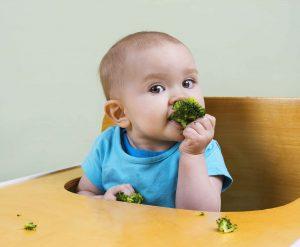
- Your baby is able to better regulate how much he or she eats. Sometimes babies can overeat when they are spoon-fed. Check out our article called are you choo-chooing your way to an overeater?
- BLW foods can be easier to prepare than purees since your baby eats what the rest of the family eats. The portion you prepare for your baby may take a little more time to cook so that you can soften the food a little more than the food your family is eating.
- Parents have been doing this for years, but it hasn’t had a name until recently.
- Pickiness and food refusal can be less likely with BLW. Since your baby is eating normal family foods from the start, there isn’t the transition from baby foods to lumpier purees to family meals, which many babies find difficult (1).
- Self-feeding can be more enjoyable for your baby since your baby is doing what he or she sees the rest of the family doing.
- Since babies are self-feeding, they get a lot more practice picking up food and developing their pincer grasp. Babies normally develop their pincer grasp around 9 months of age.
Cons of BLW: 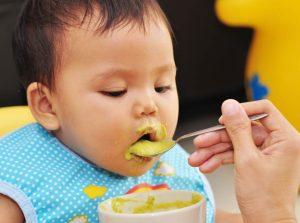
- Mealtimes can last longer than if you spoon-fed your baby.
- Other parents might judge that you are being lazy by not making your own baby food.
- Babies may not eat enough solid foods early on while he or she figures out how to “eat” independently.
- Some babies struggle with self-feeding.
- Self-feeding can be much messier than spoon-feeding.
Regardless of the method you decide on, around 8-9 months, let your baby try feeding him or herself. Provide the right type of finger foods and closely observe your child while trying these new foods. Check out our article for What’s Normal Eating around 9-12 Months to better understand eating milestones.
Why More Parents Do Not Do BLW (Self-Feeding)
 In many surveys, parents identify time and cleanliness as big reasons for not letting their child self-feed, and food waste is a third reason often mentioned (2).
In many surveys, parents identify time and cleanliness as big reasons for not letting their child self-feed, and food waste is a third reason often mentioned (2).
The biggest reason usually mentioned is that parents are afraid their child will choke. Introducing solid foods can be a fun and scary time for parents. It’s normal to be scared that your child will choke. Check out this article all about understanding your baby’s gag reflux, choking and other feeding challenges that can happen.
Self-Feeding:
Check out our mega list of first finger foods to encourage self-feeding.
Spoon-Feeding: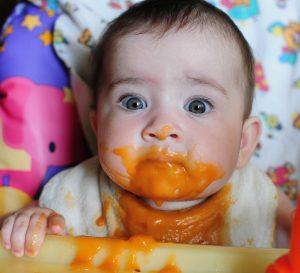
Find out how to make your own baby food, fruit puree recipes, vegetable puree recipes and mixture of fruit and vegetable puree recipes.
Also, check out our ultimate guide to introducing solid foods to your baby. It has everything I wish someone told me when I was first introducing foods to my babies.
 Sources:
Sources:
(1) Rapley, Gill, and Tracey Murkett. Baby-led Weaning: The Essential Guide to Introducing Solid Foods and Helping Your Baby to Grow up a Happy and Confident Eater. New York: Experiment, 2010. Print.
(2) “Infant – Food and Feeding.” American Academy of Pediatrics. N.p., n.d. Web.
The information on this website is designed for educational and/or entertainment purposes only. The information provided is not intended to be a substitute for informed medical advice or care. Please consult a doctor with any questions or concerns regarding your child’s condition. You should not use this information to diagnose or treat any health problems or illnesses.

